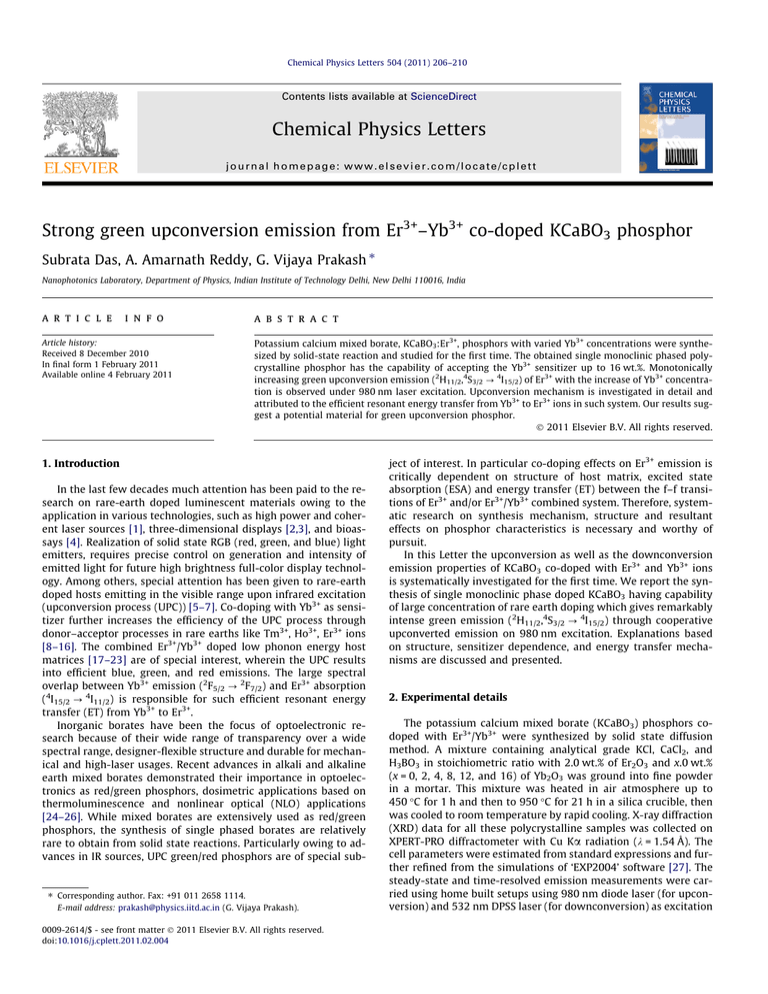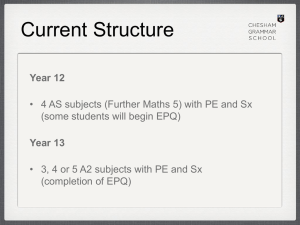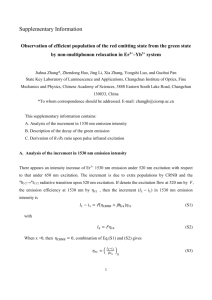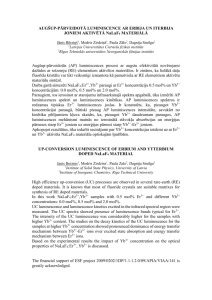
Chemical Physics Letters 504 (2011) 206–210
Contents lists available at ScienceDirect
Chemical Physics Letters
journal homepage: www.elsevier.com/locate/cplett
Strong green upconversion emission from Er3+–Yb3+ co-doped KCaBO3 phosphor
Subrata Das, A. Amarnath Reddy, G. Vijaya Prakash ⇑
Nanophotonics Laboratory, Department of Physics, Indian Institute of Technology Delhi, New Delhi 110016, India
a r t i c l e
i n f o
Article history:
Received 8 December 2010
In final form 1 February 2011
Available online 4 February 2011
a b s t r a c t
Potassium calcium mixed borate, KCaBO3:Er3+, phosphors with varied Yb3+ concentrations were synthesized by solid-state reaction and studied for the first time. The obtained single monoclinic phased polycrystalline phosphor has the capability of accepting the Yb3+ sensitizer up to 16 wt.%. Monotonically
increasing green upconversion emission (2H11/2,4S3/2 ? 4I15/2) of Er3+ with the increase of Yb3+ concentration is observed under 980 nm laser excitation. Upconversion mechanism is investigated in detail and
attributed to the efficient resonant energy transfer from Yb3+ to Er3+ ions in such system. Our results suggest a potential material for green upconversion phosphor.
Ó 2011 Elsevier B.V. All rights reserved.
1. Introduction
In the last few decades much attention has been paid to the research on rare-earth doped luminescent materials owing to the
application in various technologies, such as high power and coherent laser sources [1], three-dimensional displays [2,3], and bioassays [4]. Realization of solid state RGB (red, green, and blue) light
emitters, requires precise control on generation and intensity of
emitted light for future high brightness full-color display technology. Among others, special attention has been given to rare-earth
doped hosts emitting in the visible range upon infrared excitation
(upconversion process (UPC)) [5–7]. Co-doping with Yb3+ as sensitizer further increases the efficiency of the UPC process through
donor–acceptor processes in rare earths like Tm3+, Ho3+, Er3+ ions
[8–16]. The combined Er3+/Yb3+ doped low phonon energy host
matrices [17–23] are of special interest, wherein the UPC results
into efficient blue, green, and red emissions. The large spectral
overlap between Yb3+ emission (2F5/2 ? 2F7/2) and Er3+ absorption
(4I15/2 ? 4I11/2) is responsible for such efficient resonant energy
transfer (ET) from Yb3+ to Er3+.
Inorganic borates have been the focus of optoelectronic research because of their wide range of transparency over a wide
spectral range, designer-flexible structure and durable for mechanical and high-laser usages. Recent advances in alkali and alkaline
earth mixed borates demonstrated their importance in optoelectronics as red/green phosphors, dosimetric applications based on
thermoluminescence and nonlinear optical (NLO) applications
[24–26]. While mixed borates are extensively used as red/green
phosphors, the synthesis of single phased borates are relatively
rare to obtain from solid state reactions. Particularly owing to advances in IR sources, UPC green/red phosphors are of special sub-
⇑ Corresponding author. Fax: +91 011 2658 1114.
E-mail address: prakash@physics.iitd.ac.in (G. Vijaya Prakash).
0009-2614/$ - see front matter Ó 2011 Elsevier B.V. All rights reserved.
doi:10.1016/j.cplett.2011.02.004
ject of interest. In particular co-doping effects on Er3+ emission is
critically dependent on structure of host matrix, excited state
absorption (ESA) and energy transfer (ET) between the f–f transitions of Er3+ and/or Er3+/Yb3+ combined system. Therefore, systematic research on synthesis mechanism, structure and resultant
effects on phosphor characteristics is necessary and worthy of
pursuit.
In this Letter the upconversion as well as the downconversion
emission properties of KCaBO3 co-doped with Er3+ and Yb3+ ions
is systematically investigated for the first time. We report the synthesis of single monoclinic phase doped KCaBO3 having capability
of large concentration of rare earth doping which gives remarkably
intense green emission (2H11/2,4S3/2 ? 4I15/2) through cooperative
upconverted emission on 980 nm excitation. Explanations based
on structure, sensitizer dependence, and energy transfer mechanisms are discussed and presented.
2. Experimental details
The potassium calcium mixed borate (KCaBO3) phosphors codoped with Er3+/Yb3+ were synthesized by solid state diffusion
method. A mixture containing analytical grade KCl, CaCl2, and
H3BO3 in stoichiometric ratio with 2.0 wt.% of Er2O3 and x.0 wt.%
(x = 0, 2, 4, 8, 12, and 16) of Yb2O3 was ground into fine powder
in a mortar. This mixture was heated in air atmosphere up to
450 °C for 1 h and then to 950 °C for 21 h in a silica crucible, then
was cooled to room temperature by rapid cooling. X-ray diffraction
(XRD) data for all these polycrystalline samples was collected on
XPERT-PRO diffractometer with Cu Ka radiation (k = 1.54 Å). The
cell parameters were estimated from standard expressions and further refined from the simulations of ‘EXP2004’ software [27]. The
steady-state and time-resolved emission measurements were carried using home built setups using 980 nm diode laser (for upconversion) and 532 nm DPSS laser (for downconversion) as excitation
207
S. Das et al. / Chemical Physics Letters 504 (2011) 206–210
sources. The emission light was dispersed into a monochromator
(Acton SP2300) coupled to a photo multiplier tube (PMT) through
appropriate lens system. For time resolved emission, mechanical
chopper (12 Hz), lock-in amplifier, and digital storage oscilloscope
were employed to record the transient response.
3. Results and discussions
3.1. X-ray diffraction
The room temperature XRD patterns of un-doped KCaBO3 and
x.0 wt.% Yb3+ (x = 2 and 16) doped KCaBO3:Er3+ phosphors are
shown in the Figure 1. Obtained d-values from powder XRD data
have been compared to that of similar un-doped LiBaBO3 (JCPDS
81-1808) [28] and indexed accordingly. The sharp and single peaks
of the XRD pattern suggest the formation of single-phase polycrystalline and can be identified as monoclinic crystal structure of
space group P21/c (14). Recently series of alkali and alkaline earth
metal mixed borates have been investigated and produced large
family of materials with different crystalline phases [24–
26,28,29]. However the present study confirms that the synthesized material is single-phased KCaBO3. Moreover, the observation
of enhanced XRD peaks (ex: (1 1 2), (2 1 0)) without any peak shift
appeared upon Er3+/Yb3+ doping, indicating no significant changes
in the host crystal structure with the doping. Table 1 further suggesting that the doping indeed facilitates the better crystallinity
with interstitial incorporation and possibility of heterogeneous
nucleation. The grain sizes estimated from the well-known Scherrer equation are in the range of 50–75 nm.
3.2. Downconversion emission under 532 nm excitation
The visible emission of KCaBO3:Er3+ co-doped with various Yb3+
concentrations on excited with 532 nm laser is shown in Figure 2A.
The spectra shows strong emission at around 547 nm with two low
intense emissions at 830 and 980 nm, attributed to the Er3+ ion
transitions 4S3/2, 4I9/2 and 4I11/2 to the ground state 4I15/2, respec-
Table 1
Estimated lattice parameters of un-doped KCaBO3 and x.0 wt.% Yb3+ (x = 2 and 16)doped KCaBO3:Er3+powders.
Compound
a (Å)
b (Å)
c (Å)
a
b
c
KCaBO3
KCaBO3:2 wt.%Er3+-2 wt.% Yb3+
KCaBO3:2wt.%Er3+-16wt.% Yb3+
11.46
11.97
11.75
6.90
6.95
6.90
7.25
7.09
7.05
90°
90°
90°
117.51°
117.90°
118.51°
90°
90°
90°
tively. Here, Er3+ ions are directly excited to 2H11/2 and major parts
of them deactivates to the ground state by emitting green light,
along with other possible channels of radiative and non radiative
decays (schematically shown in Figure 2B). Such downconversion
(DC) emission intensities found same for all samples, irrespective
of Yb3+ sensitizer concentration (Figure 2A).
3.3. Upconversion emission under 980 nm excitation
Upconversion (UC) is a sequential absorption of two infrared
photons by rare earth ion low-energy, followed by the emission
of visible photons from high-energy levels. The upconversion emission spectra of various Yb3+-doped KCaBO3:Er3+phosphors, excited
with 980 nm laser, has been recorded in the spectral region of 300–
800 nm and shown in Figure 3. The upconversion emission spectra
is dominated by the strong green emission of Er3+, which is even
visible to the naked eye (digital image are depicted as inset in
Figure 3), at 524 and 545 nm are from transitions 2H11/2, 4S3/2 to
the ground state 4I15/2 of Er3+, respectively. Other emission bands
at around 487, 656 and 830 nm are corresponding to the transitions 4F7/2, 4F9/2 and 4I9/2 to 4I15/2 of Er3+, respectively. However,
the KCaBO3:Er3+ powders with Yb3+ = 0 shows a faint emission at
830 nm (4I9/2 ? 4I15/2). This might be due to weak absorption
cross-section of 4I13/2 transition and large phonon energy of KCaBO3
host [30], which could result into a quick multi-phonon relaxation
between the energy levels of Er3+ ion (Figure 2B). Moreover as Yb3+
ion concentration is increasing, the green emission (2H11/2,4S3/2 ?
4
I15/2) of Er3+ increasing monotonically, suggesting the important
Figure 1. XRD pattern of un-doped KCaBO3 and x.0 wt.% Yb3+ (x = 2 and 16) co-doped KCaBO3:Er3+ at room temperature. Standard data of LiBaBO3 (JCPDS 81-1808) is also
given for comparison.
208
S. Das et al. / Chemical Physics Letters 504 (2011) 206–210
Figure 2. (A) Represents the DC emission of x.0 wt.% Yb3+ (x = 0, 2, 4, 8, 12 and 16) co-doped KCaBO3:Er3+ phosphors at room temperature. kex = 532 nm. (B) The schematic
energy levels of Er3+ and Yr3+ ions containing UC and DC excitation and emission schemes.
Figure 3. UC emission of KCaBO3:Er3+ phosphors doped with different x.0 wt.% co-doping of Yb3+ (x = 0, 2, 4, 8, 12 and 16) at room temperature. kex = 980 nm.
role of the energy transfer process between sensitizer (Yb3+) to the
active (Er3+) rare-earth ion. Essentially the Yb3+ ion is used as sensitizer since it has a very high absorption energy level
(2F5/2 ? 2F7/2) at excitation wavelength. Therefore upon excitation
with 980 nm, apart from excited state absorption (ESA), an efficient
energy transfer (ET) from Yb3+ to Er3+ is possible due to spectral
overlap between Yb3+ transition of 2F5/2 ? 2F7/2 and that of Er3+
absorption energy 4I11/2 ? 4I15/2, which significantly improves the
UC emission process (schematic Figure 2B).
The enhancement in the upconverted emission intensities as a
function of Yb3+ concentration can be explained on the basis of
modification of inter ionic distance between the Er3+ and Yb3+ ions.
With the increase of Yb3+ ion concentration, the average distance
between the Er3+ and Yb3+ ions decreases, which automatically
Table 2
The UC and DC emission lifetimes and Green-to-Red (G/R) integrated UC emission
ratios of KCaBO3:Er3+ phosphors co-doped with x.0 wt.% Yb3+ (x = 2, 4, 8, 12 and 16).
Parenthesis values of 524 nm UC emission indicate the relative integrated areas of fast
and slow components.
Yb3+ ion
concentration
(wt.%)
G/R
ratio
x=
2
4
8
12
16
4.7
5.6
6.4
6.6
7.7
524 nm UC emission
(kexc = 980 nm) (2H11/2, 4S3/2
? 4I15/2 of Er3+)
547 nm DC emission
(kexc = 532 nm) (4S3/
4
3+
2 ? I15/2 of Er )
s1(ms)
s2(ms)
s(ms)
0.69(48.00%)
2.20(34.70%)
2.30(5.78%)
2.20(9.72%)
4.60(14.15%)
0.61(52.00%)
0.22(65.30%)
0.27(94.22%)
0.29(90.27%)
0.29(85.84%)
1.00
0.85
0.86
0.92
0.95
S. Das et al. / Chemical Physics Letters 504 (2011) 206–210
209
Figure 4. The emission decay curves of (A) UC emission of 524 nm (2H11/2, 4S3/2 ? 4I15/2 of Er3+) and (B) DC emission of 547 nm (4S3/2 ? 4I15/2 of Er3+) of 16 wt.% Yb3+co-doped
KCaBO3:Er3+ phosphor. For UC and DC emission the excitation wavelengths are 980 and 532 nm, respectively.
enhance the energy transfer process from Yb3+ to Er3+ ions. Such
energy transfer increases the high energy excited-state populations of the Er3+ ions, leading to increase in the blue, green, red
and near-infrared emission intensities. Most importantly, it is seen
from the Figure 3, the intensity of the green emission increases
dramatically with the Yb3+-concentration compared to that of the
other red (656 nm) and near-infrared (830 nm) emissions. This is
possibly due to the probability of electron in the 4I11/2 state gets
promoted to the 4F7/2 states via an energy-transfer upconversion
process, which is much higher than that of nonradiative relaxation
to the 4I13/2 (for 656 nm emission) and 4I9/2 (for 830 nm emission)
states. Also the change the crystal field symmetry around rare
earth ion and crystallinity may also influence emission intensities
and broadness. The integrated UC emission intensities ratios of
green (2H11/2,4S3/2 ? 4I15/2) and red (4F9/2 ? 4I15/2) transitions for
varied Yb3+-concentrations in KCaBO3:Er3+ are given in Table 2.
The monotonic increase in the G/R intensity ratio indicating the
good crystallinity of the host, which is also evident from XRD analysis (Figure 1). Further, the increase in the inhomogeneous broadening (the width of UC emission lines) with the increase of Yb3+
concentrations can be attributed to the change in the ligand field
around Er3+ ions [31]. When the trivalent ions (Re3+) are to be
incorporated into the host matrix of divalent (such as Ca2+) ions,
the charge compensation is necessarily required. The studies of different charge compensation models on the luminescent properties
of rare-earth (Re3+) ions were reported for different hosts in the recent past [32–35]. In the present system, the charge compensation
is possible from two mechanisms: (i) 2Ca2+ = Re3+ + K+ or (ii)
3Ca2+ = 2Re3+ + interstitial vacancies [35]. Based on the observation
of enhanced luminescence properties and improved crystallinity,
the rare earth ions in the host KCaBO3 possibly occupy the charge
compensated sites of Ca2+ ions by the dominant mechanism of
2Ca2+ = Re3+ + K+.
Finally the radiative decay times, defined as the time required
for the luminescence intensity to decrease to 1/e of its initial value,
is also calculated for the most intense UC emission (524 nm,
2
H11/2 ? 4I15/2) and DC emission (547 nm, 4S3/2 ? 4I15/2) of Er3+
ion. Example decay curves are given in Figure 4 and corresponding
lifetimes were tabulated in Table 2. Interestingly, the DC emission
resulted into a single exponential whereas UC emission decay resulted as double exponential in nature. Without any interaction
between emitting rare-earth ions, the decay can be fitted to a
single exponential [36]. However, when ion-ion interactions and
energy transfer are predominant, the resultant emission could
deviate from single exponential and can have both fast and slow
components. On comparison, the UC green emission decay is predominantly faster (0.2 ms) compared to that of DC green emission (0.9 ms) and both decays are more or less invariant with
the Yb3+ sensitizer co-doping.
4. Conclusions
Single phase monoclinic KCaBO3:Er3+ phosphors with varied
Yb concentrations were synthesized by solid state diffusion technique at 950 °C and their upconversion under near-infrared excitation are reported for the first time. The UC spectra of all co-doped
samples showed strong green emission of Er3+, even visible to
naked eye, attributed to the transitions 2H11/2, 4S3/2 to ground state
of 4I15/2. The increase in the green emission intensities as a function
of sensitizer (Yb3+) concentration is explained based on modification of inter ionic distance, two photon absorption and efficient energy transfer between the Er3+ and Yb3+ ions. The monotonic
increase in the green-to-red intensity ratio suggesting the increased effects of good crystallinity, which was also supported by
X-ray diffraction analysis. Enhanced green emission from these
mixed borate phosphors could be found very useful for upconversion phosphors.
3+
Acknowledgements
Authors acknowledge the financial support from Department of
Information Technology (DIT), Govt. of India, under Photonics
Development Program (Ref. 12(1)/2008-PDD). This is work is part
of ‘High-Impact Research Scheme’ of IIT Delhi.
References
[1]
[2]
[3]
[4]
[5]
[6]
[7]
[8]
[9]
[10]
T. Sandrock, H. Scheife, E. Heumann, G. Huber, Opt. Lett. 22 (1997) 1185.
E. Dowing, L. Hesselink, J. Ralston, R. Macfarlane, Science 273 (1996) 1185.
S.Q. Xu, H.P. Ma, D.W. Fang, Z.X. Zhang, Z.H. Jiang, Mater. Lett. 59 (2005) 3066.
C.G. Morgan, S. Dad, A.C. Mitchell, J. Alloys Compd. 451 (2008) 526.
N. Tyagi, A. Amarnath Reddy, R. Nagarajan, Opt. Mater. 33 (2010) 42.
D. Dosev, I.M. Kennedy, M. Godlewski, I. Gryczynski, K. Tomsia, E.M. Goldys,
Appl. Phys. Lett. 88 (2006) 011906.
H. Lin, G. Meredith, S. Jiang, X. Peng, T. Luo, N. Peyghambarian, E. Yue-Bun Pun,
J. Appl. Phys. 93 (2003) 186.
R.H. Page, K.I. Schaffers, P.A. Waide, J.B. Tassano, S.A. Payne, W.F. Krupke, W.K.
Bischel, J. Opt. Soc. Am. B 15 (1998) 996.
N. Menyuk, K. Dwight, J.W. Pierce, Appl. Phys. Lett. 21 (1972) 159.
G. Blasse, B.C. Grabmaier, Luminescent Materials, Springer Verlag, Berlin, 1994.
p. 195.
210
S. Das et al. / Chemical Physics Letters 504 (2011) 206–210
[11] F. Auzel, in: B. Di Bartolo (Ed.), Spectroscopy and Dynamics of Collective
Excitations in Solids, Plenum, New York, 1997, p. 537.
[12] M. Malinowski, Z. Frukacz, M.F. Joubert, B. Jacquier, J. Lumin. 75 (1997) 333.
[13] I.R. Martin, V.D. Rodriguez, V. Lavin, U.R. Rodriguez-Mendoza, J. Lumin. 72–74
(1997) 954.
[14] B. Simondi-Teisseire, B. Viana, D. Vivien, A.M. Lejus, Opt. Mater. 6 (1996)
267.
[15] J.A. Hutchinson, H.R. Verdun, B.H.T. Chai, L.D. Merkle, Opt. Mater. 3 (1994) 287.
[16] E. Cantelar, F. Cusso, Appl. Phys. B: Lasers Opt. 69 (1999) 29.
[17] L. Wang, X. Xue, H. Chen, D. Zhao, W. Qin, Chem. Phys. Lett. 485 (2010) 183.
[18] H.S. Biao Dong et al., J. Phys. Chem. C 112 (2008) 1435.
[19] A. Patra, P. Ghosh, P.S. Chowdhury, M. Alencar, B.W. Lozano, N. Rakov, G.S.
Maciel, J. Phys. Chem. B 109 (2005) 10142.
[20] C.H. Liu, D.P. Chen, J. Mater. Chem. 17 (2007) 3875.
[21] H.X. Mai, Y.W. Zhang, L.D. Sun, C.H. Yan, J. Phys. Chem. C 111 (2007) 13721.
[22] G.Y. Chen, Y. Liu, Z.G. Zhang, B. Aghahadi, G. Somesfalean, Q. Sun, F.P. Wang,
Chem. Phys. Lett. 448 (2007) 127.
[23] G. Kaur, S.K. Singh, S.B. Rai, J. Appl. Phys. 107 (2010) 073514.
[24] P. Li, Z. Wang, Z. Yang, Q. Guo, G. Fu, X.Z. Li, Y.P. Xu, Mater. Res. Bull. 44 (2009)
2068.
[25] Z. Wang, Z. Yang, P. Li, Q. Guo, Y. Yang, J. Rare Earths 28 (2010) 30.
[26] L. Wu, X.L. Chen, H. Li, M. He, Y.P. Xu, X.Z. Li, Inorg. Chem. 44 (2005) 6409.
[27] A. Altomare et al., J. Appl. Cryst. 37 (2004) 1025.
[28] M. Schlaeger, R.Z. Hoppe, Anorg. Allg. Chem. 619 (1993) 976.
[29] L. Wu, Y. Zhang, Y.F. Kong, T.Q. Sun, J.J. Xu, X.L. Chen, Inorg. Chem. 46 (2007)
5207.
[30] Z. Shang, G. Ren, Q. Yang, C. Xu, Y. Liu, Y. Zhang, Q. Wu, J. Alloy. Comp. 460
(2007) 539.
[31] V.K. Komarala, Y. Wang, M. Xiao, Chem. Phys. Lett. 490 (2010) 189.
[32] P. Li, Z. Zhang, K. Zhang, Z. Yang, Z. Wang, Q. Guo, Chin. Phys. Lett. 6 (2008)
274.
[33] A. Xie, X. Yuan, F. Wang, Y. Shi, Z. Mu, J. Phys. D: Appl. Phys. 43 (2010) 055101.
[34] A.J. Lenus, M.T. Jose, M. Yousuf, K.G. Rajan, A.R. Lakshmanan, Radiat. Meas. 33
(2001) 397.
[35] J. Liu, H. Lian, C. Shi, Opt. Mater. 29 (2007) 1591.
[36] G. Lakshminarayana, H. Yang, J. Qiu, J. Solid State Chem. 182 (2009) 669.








